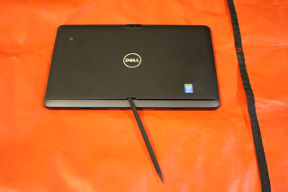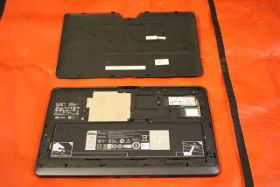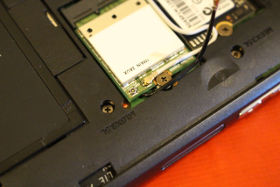Preface
Last Updated: 20/07/2017Hello World
As part of cleaning up, everything relating to the DV11 has moved to this sub-page.
Google Bait
Running Linux on Dell Venue 11 Pro (7130)
Ye ol' Index
- Device Status :: What works, what does not work.
- Preliminaries :: Start at the beginning.
- Power Management :: Stability and Battery life.
- X.org :: A GUI is not a bad thing to have.
- Wayland :: Nostalgia for the Future.
- Firmware :: Blobs, Binary Blobs everywhere.
- Near-Field Communication :: NFC on Venue 11.
- Wireless.alt.venue11 :: Swap Module, Results Get!
- Wireless 'ath6kl' :: The mystery of the dropping packets.
- Bluetooth :: Something's there, can't quite reach.
- Hardware Buttons :: "Brave Press!"
- Fun with Industrial I/O :: Watch the little sensors.
- Venue 11 Pro Summary :: Silicon Insides.
- Revision Log :: How this article has grown.
Status
Currently Running
Fedora 25 on Venue 11, Kernel 4.11.8
OpenSUSE Tumbleweed on Venue 11, Kernel 4.11.8
Bug Reports
@kernel.org ----------- #67921 - Dell Wireless 1537 / 1538 support #73081 - Fail to setup bluetooth on Dell Venue 8 / 11 Pro #102281 - Venue 11 power button not detected / handled #109231 - O2 Micro, SD/MMC Card Reader doesn't work
Device Status
Dell Venue 11 Pro, 7130, on Kernel 4.11.8
- More or less like a normal PC in tablet form.
- Performed stock install from USB stick. - MicroSD card slot is NOT bootable.
- System will only boot from USB or internal SSD.
- System can PXE boot when combined with Venue Dock.
- Untested: RootFS on MicroSD. Grub, Kernel, InitRD on SSD. - Core i3-4020Y @ 1.50Ghz, 4GB, BIOS A12
- 64-bit UEFI, boots any X64 distro from USB.
- With keyboard flap / case, just like a Laptop.
- Keyboard flap can be "hotplugged".
- Depends on flap having been there since cold-boot. - Stock Intel Core-series hardware, just works™.
- MicroSD slot (O2 Micro), works with kernel flag. #109231
- sdhci.debug_quirks2 = "0x10000"
- hdparm -t: 57MB per second, 32GB Samsung Pro µSD.
- Copying files to card, 50MB to 79MB per second. - CPU frequency scaling / power states
- Battery Status
- Device Charging while Linux is operational.
- Reboot, Shutdown.
- Suspends AND wakes properly.
- Works with keyboard flap folding and unfolding to screen.
- Works with pressing keyboard keys or touching trackpad.
- Temperamental when attempting wake power button. #102281 - X.org
- 2D, 3D and standard / accelerated video playback. (H264)
- WM's Tested: Gnome, XFCE
- Backlight Brightness / DPMS
- (Multi) Touchscreen and Stylus, Lanscape.
- Pen input: alt-button, 255 pressure levels - (Multi) Touchscreen and Stylus, alternate orientations.
- Manual: Script talks to xrandr and evdev.
- Automatic: Checkout iio-proxy. - Gnome on Wayland
- Sound Output, Speaker / Headphones works.
- Headphones automatically detected and switched. - Sound Input, Internal microphones.
- Capture channels: Front Left - Front Right - Sound Input, Apple earbuds mic.
- 0x19 or 0x1a not reported for ALC3223?
- ToDo: play with hdajackretask - WiFi: Dell Wireless 1537, registers in kernel.
- Chip is similar to Venue 8, different revision.
- Needs kernel patch as Device ID is not yet in mainline.
- Barely registers WiFi networks.
- Pretty much useless at this point in time. - WiFi: Qualcomm Atheros AR9462
- WiFi: Qualcomm Atheros QCA9565 / AR9565
- WiFi: Intel Wireless 7260
- WiFi: Intel Wireless 8260
- Accelerometer, Ambient Light Sensor, Gyro, etc.
- Hardware Buttons: Power, Volume Up, Volume Down, Meta
- Touch sensitive front "branded" button
- Front "Status" LED
- Turns on with Camera.
- Suppose it could be coaxed for status purposes. - Bluetooth: Dell Wireless 1537.
- Bluetooth: Qualcomm Atheros AR9462
- Bluetooth: Qualcomm Atheros QCA9565 / AR9565
- Bluetooth: Intel Wireless 7260
- Bluetooth: Intel Wireless 8260
- Bluetooth Tested with Apple Keyboard and Mouse.
- Bluetooth at Gnome Login Screen, so KB + Mouse work:
- systemctl enable bluetooth.service - NFC: According to Dell, stock on all Venue Pro 11's.
- NXP PN544 NFC chip on a i2c bus.
- Needs Intel NFC Middleware to function. - Front Camera - OV 2722, Yes.
- USB, 0bda:5751, V4L2, Realtek Semiconductor Corp.
- Patch is now merged by Uncle Torvalds.
- Pre 4.10 Kernels, need patch
- Confirmed by by Infernix, 09/2016 - Back Camera - IMX 175, Yes.
- USB, 114d:1000, V4L2, Alpha Imaging Technology Corp. - Mini HDMI port:
- Primary, Extend and Mirror modes.
- Hotplug DVI monitor 1920x1080
- Hotplug HDMI television 1920x1080 + Audio
- Use "pavucontrol" to direct audio to HDMI port
Dell Venue 11 Pro, Camera Test Commands
- Front Camera:
[~]$ mpv tv:// --tv-driver=v4l2 --tv-device=/dev/video0 - Back Camera:
[~]$ mpv tv:// --tv-driver=v4l2 --tv-device=/dev/video1
Dell Venue 11 Pro, Dock Functionality
- Working Correctly
- Ethernet via USB, ASIX Electronics Corp. AX88772X
- Charging
- Headphone Port
- USB Hub - Non Functional
- HDMI output, monitor detected correctly but no output.
- DisplayPort output, monitor detected but no output.
- drm/i915: *ERROR* Timed out waiting for DP idle patterns
- drm/i915: *ERROR* failed to train DP, aborting. (4.9)
MicroSD Card Slot Notes
Per Dell: SD card slot speeds on Dell Venue Tablets
Thread: Dell Venue 128GB MicroSD card support
- uSD Cards used for testing
- 8GB, SanDisk Ultra (SDSDQUA-008G-UQ46A)
- 16GB, G.Skill (FF-TSDG32GA-C10)
- 32GB, Samsung Pro (MB-MG32D)
- 64GB, G.Skill (FF-TSDXC64GA-U1)
- Venue 11 Pro (7130)
- SDHC, SDXC Support
- Bus Speed: 50MB/s (SDR50, DDR50), 104MB/s (SDR104)
- Tested: 32GB, 64GB card sizes.
- Untested: 128GB
Overall Experience
Apart from power button / keyboard flap quirks, no complaints.
Preliminaries
The Venue 11 will basically run anything, because it's effectively behaving like a normal PC.
Public Service Announcements
GDM / LightDM notes.
Power Management
Suspend / Hibernate Fine.
Power Button Bug.
X.org
Just works.
Wayland
Likewise, works.
Firmware
Atheros 6K / Dell 1537 wireless
For wifi to work we need a newer release of the ath6kl firmware then is
currently shipped in the Linux firmware package.
Qualcomm has these in their ath6kl firmware repo.
The AR6004 folder sits in /lib/firmware/ath6k/ on your filesystem.
Near-field communication (NFC)
Hardware Requirements
The Venue 11 Pro series ship with an NXP PN544 NFC chip.
Software Requirements
Be advised, libnfc is not compatible with PN544 hardware.
The NFC module can be poked at if you go through the effort of compiling the Linux-NFC middleware made by Intel. Fedora doesn't seem to have this package in the default repo.
Everything else is already in place from Kernel 3.12 onward.
For other distributions you may be able to find the "neard" package:
- In AUR for Arch.
- In Sid (Unstable) for Debian.
- In the Offical Repo for OpenSuse.
The "neard" application manages everything pretty much but more importantly it contains a number of tools that allow us to verify NFC functionality.
Perhaps a source of enlightenment, the Intel NFC bugtracker.
TL;DR; nfctool
[root@DV11 neard]# ./tools/nfctool/nfctool -l
nfc0:
Tags: [ ]
Devices: [ ]
Protocols: [ Felica MIFARE Jewel ISO-DEP NFC-DEP ]
Powered: No
RF Mode: None
lto: 150
rw: 15
miux: 2047
Working with "neard"
Assuming you've succesfully compiled / package installed the middleware here's a series of commands that may offer some insight.
First start the monitoring tool.
[root@DV11 neard]# ./test/monitor-near
Then launch "neard" in another terminal
[root@DV11 neard]# ./src/neard
The monitor output should now have been updating like thus
# monitor-near
{Added org.neard.Adapter} [/org/neard/nfc0]
Protocols = dbus.Array([dbus.String(u'Felica'), dbus.String(u'MIFARE'), dbus.String(u'Jewel'), dbus.String(u'ISO-DEP'), dbus.String(u'NFC-DEP')], signature=dbus.Signature('s'), variant_level=1)
Mode = Idle
Polling = 0
Powered = 0
{Added org.freedesktop.DBus.Introspectable} [/org/neard/nfc0]
{Added org.freedesktop.DBus.Properties} [/org/neard/nfc0]
{Added org.neard.PHDC} [/org/neard]
You should now be able to read out the basics of the NFC hardware
[root@DV11 neard]# ./test/test-adapter list
[ /org/neard/nfc0 ]
Protocols = [ Felica MIFARE Jewel ISO-DEP NFC-DEP ]
Mode = Idle
Polling = false
Powered = false
Proceed to turn the hardware on and it will trigger the loading and initialization of the PN544 module + friends.
[root@DV11 neard]# ./test/test-adapter powered nfc0 on
# monitor-near
{Adapter.PropertyChanged} [/org/neard/nfc0] Powered = 1
# dmesg
[ 196.457542] mei_phy: nfc_mei_phy_enable
[ 196.464087] mei_phy: mei_nfc_if_version
[ 196.486181] mei_phy: mei_nfc_connect
[ 196.490400] mei_phy: IVN 0x1 Vendor ID 0x1
[ 196.490403] mei_phy: ME FW 9.5.30.1808
[ 196.991726] FULL VERSION SOFTWARE INFO: b1 02 01 02 00 01 02 0a 02 0a 02
[ 196.999684] hci: hci_dev_version: SOFTWARE INFO:
[ 196.999686] hci: hci_dev_version: RomLib : 11
[ 196.999687] hci: hci_dev_version: Patch : 1
[ 196.999688] hci: hci_dev_version: FlashLib Major : 2
[ 196.999689] hci: hci_dev_version: FlashLib Minor : 10
[ 196.999689] hci: hci_dev_version: HARDWARE INFO:
[ 196.999690] hci: hci_dev_version: Derivative : 3
[ 196.999691] hci: hci_dev_version: HW Version : 2
[ 196.999691] hci: hci_dev_version: #MPW : 0
[ 196.999692] hci: hci_dev_version: Software : 0
[ 196.999693] hci: hci_dev_version: BSID Version : 3
Enable Polling mode so the NFC radio will be able to "scan" for a tag and (facing the front of the unit) swipe something with RFID along the back of the right hand side.
Keep in mind that while testing polling will automatically get disabled again after an NFC activity has completed. Likewise scanned information is immediately discarded when using these test tools.
[root@DV11 neard]# ./test/test-adapter poll nfc0 on initiator
# monitor-near
{Added org.neard.Tag} [/org/neard/nfc0/tag0]
Protocol = ISO-DEP
ReadOnly = 0
Type = Type 4A
Adapter = /org/neard/nfc0
{Added org.freedesktop.DBus.Introspectable} [/org/neard/nfc0/tag0]
{Added org.freedesktop.DBus.Properties} [/org/neard/nfc0/tag0]
{Removed org.freedesktop.DBus.Properties} [/org/neard/nfc0/tag0]
{Removed org.freedesktop.DBus.Introspectable} [/org/neard/nfc0/tag0]
{Removed org.neard.Tag} [/org/neard/nfc0/tag0]
{Adapter.PropertyChanged} [/org/neard/nfc0] Mode = Idle
Alternatively with NFCard on Android sending a URL "record" to the Venue 11 Pro.
[root@DV11 neard]# ./test/test-adapter poll nfc0 on initiator
# monitor-near
{Added org.neard.Device} [/org/neard/nfc0/device15]
Adapter = /org/neard/nfc0
{Added org.freedesktop.DBus.Introspectable} [/org/neard/nfc0/device15/record0]
{Added org.neard.Record} [/org/neard/nfc0/device15/record0]
Type = URI
URI = http://play.google.com/store/apps/details?id=com.android.apps.tag&feature=beam
{Added org.freedesktop.DBus.Properties} [/org/neard/nfc0/device15/record0]
{Added org.freedesktop.DBus.Introspectable} [/org/neard/nfc0/device15/record1]
{Added org.neard.Record} [/org/neard/nfc0/device15/record1]
Type = AAR
AAR = com.android.apps.tag
{Added org.freedesktop.DBus.Properties} [/org/neard/nfc0/device15/record1]
Again with NFCard but now we use Peer to Peer mode, receiving a "P2P" URL from the app upon tapping the Android device screen to initiate communication.
[root@DV11 neard]# ./test/test-adapter poll nfc0 on target
# monitor-near
{Added org.freedesktop.DBus.Introspectable} [/org/neard/nfc0/device0]
{Added org.freedesktop.DBus.Properties} [/org/neard/nfc0/device0]
{Added org.neard.Device} [/org/neard/nfc0/device0]
Adapter = /org/neard/nfc0
{Added org.freedesktop.DBus.Introspectable} [/org/neard/nfc0/device0/record0]
{Added org.neard.Record} [/org/neard/nfc0/device0/record0]
Type = URI
URI = http://play.google.com/store/apps/details?id=com.sinpo.xnfc
{Added org.freedesktop.DBus.Properties} [/org/neard/nfc0/device0/record0]
Lastly, we'll send a test message via Peer to Peer mode to the Android device. Now the moment you hold your device to the Venue Pro "neard" will start to establish a device entity.
[root@DV11 neard]# ./test/test-adapter poll nfc0 on target
#monitor-near
{Added org.freedesktop.DBus.Introspectable} [/org/neard/nfc0/device17]
{Added org.freedesktop.DBus.Properties} [/org/neard/nfc0/device17]
{Added org.neard.Device} [/org/neard/nfc0/device17]
Adapter = /org/neard/nfc0
You'll now have a short window of opportunity to verify the device entity and send a test example over. There are a number of options which can be found by doing a dry run with the "test-device" tool but here we opt for simple text.
[root@DV11 neard]# ./test/test-device dump [ /org/neard/nfc0/device17 ] [root@DV11 neard]# ./test/test-device push /org/neard/nfc0/device17 Text UTF-8 en-US "Hello World, I finally got it to work."
At this point your device should have received the test text string and "neard" will return to idle.
It should be possible to write tags but I lack any further NFC elements bar the Android phone used for testing.
Tiny Hat Tip to this Texas Instruments PDF document which was helpful in getting the polling clues. Pages 7 to 15 show a series of NFC examples including writing RFID tags.
Wireless .alt.venue11
M.2 / NGFF Modules
The Venue 11 7130 has a user accessible M.2 slot in which we can swap a better functioning WiFi / Bluetooth module until the Dell Wireless 1537 is more functional. Dell's BIOS in this model doesn't seem to employ any form of white listing unlike other vendors (I'm looking at you here Lenovo & HP) so I've been able to test a number of "unofficial" cards without limitations.
Seeing as my parts pile didn't get any interesting samples I went ahead and ordered a couple more cards to round out the list of options. This should statisfy both purists and those who favour Intel cards. I have no intention to look at Broadcom cards at this time unless one happens to come by and I have time.
ToDo: Note Bluetooth Kernel modules.
Atheros "ath9k" cards
For further background information consult the ath9k Wiki
- Qualcomm Atheros AR9462, Kernel pre-4.8.6
- Wifi only.
- Bluetooth causes XHCI USB enumeration errors.
- Qualcomm Atheros AR9462, Kernel 4.8.6+
- Full WiFi and Bluetooth support. - Qualcomm Atheros QCA9565 / AR9565
- Full WiFi and Bluetooth support.
Intel "iwlwifi" cards
For further background information consult the iwlwifi Wiki
- Intel Wireless 7260
- Full WiFi and Bluetooth support. - Intel Wireless 8260
- Full WiFi and Bluetooth support.
Swapping WiFi Cards
Proceed with the following at your own peril. Remember to be patient, don't force things and it's also a good idea to read the instructions in full first. If you don't feel confident you can perform this procedure ask someone with more skill to do it for you. Realistically it shouldn't take more then 5 - 10 minutes if that.
- Make sure your battery is more then 80% charged.
- Make sure you are working in an ESD-safe manner.
- Seriously, respect Electrostatic Discharge. Good hardware should not be wasted because you couldn't spend $10 on an ESD strap.
- Pop off the back panel.
- Remove the battery.
1. Slide the lock button to the right.
2. Lift battery out. - Carefully remove the connected antennas.
- Remove the retaining screw holding the card in slot.
- Lift the current card slightly upwards and pull / lift.
- Insert new card with same slight angle.
Protip: It will only fit one way. - Push card all the way into slot and push down.
- Return the retaining screw back in place.
- Carefully connect antenna's again.
Pay attention and you should feel a tiny "click". - White Lead on the SSD oriented connector.
- Black Lead on the Battery oriented connector.
- Leave the battery out for a minute or two.
- Insert battery, connect charger.
At this point your Venue 11 may not immediatly respond to you pressing the power button. Don't Panic. What tends to happen in my case is the following after swapping cards. (PBP = Power Button Press)
- First PBP
- Power light on side blinks once. - Second PBP
- Internal fan spins up in full.
- Stops after a couple of seconds. - Third PBP
- Vibration motor whirs as you'd normally expect
- But no POST. - Fourth PBP
- Vibration motor whirs
- Unit POSTs succesfully.
- May optionally complain about incorrect date and time.
I'm assuming the Venue 11 adjusting to a new hardware configuration is a multi-step process internally and thus the outlined behaviour. What ever you do, be patient between power button presses.
Wireless "ath6kl"
Wireless ID not in Kernel yet.
Found the wireless card again, will have a look at testing when I have time.
Easiest to install a supported Atheros or Intel card at the moment.
Bluetooth
Works with third party card installed.
ALSA
Just works.
Hardware Buttons
For the Venue 11 the "soc_button_array" module is needed
By default the mappings are thus:
- Power - ACPI power button.
- Volume Up
- XF86AudioLowerVolume
- X11: Keycode 123
- TTY: keycode 115 - Volume Down
- XF86AudioRaiseVolume
- X11: Keycode 122
- TTY: keycode 114 - Meta, "home" button with branding.
- Super_L
- X11: Keycode 133
- TTY: keycode 125
Power Button
On the Venue 11 the power button is not detected (#102281), everything else is.
Fun with Industrial I/O
See IIO segment on parent page.
System Summary (DV11P)
Atheros SDIO Wifi (ath6kl)
Dell Venue 11 Pro
- cat /sys/bus/sdio/devices/mmc0:0001:1/device
- 0x0419 - cat /sys/bus/sdio/devices/mmc0:0001:1/vendor
- 0x0271 - cat /sys/bus/sdio/devices/mmc0:0001:1/modalias
- sdio:c00v0271d0419
Revision Log
July/2017
- Migrated DV11 to sub-page
//- Rev -// v0.x // Epoch



